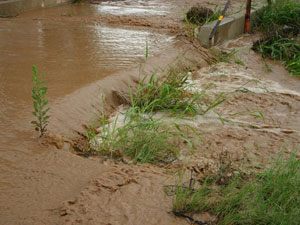Storms & Flooding
 California residents know that earthquakes are a threat and that being prepared can make a real difference. Many of the same measures taken in preparing for an earthquake will work well during winter storms and resulting flooding. Be prepared for flooding by learning what to do before, during, and after. Print out and keep a copy of this information with your supplies.
California residents know that earthquakes are a threat and that being prepared can make a real difference. Many of the same measures taken in preparing for an earthquake will work well during winter storms and resulting flooding. Be prepared for flooding by learning what to do before, during, and after. Print out and keep a copy of this information with your supplies.
Before the Storm:
- Check your homeowner's or renter's insurance for flood insurance coverage. If none exists and your home is in a flood plain, contact your insurance agent.
- Keep your car fueled and ready to go.
- Know safe routes to higher, safe ground from your home and workplace.
- Keep sandbags, plywood, plastic sheeting, lumber, and other emergency building materials handy for waterproofing. For a list of San Diego County sandbag vendors, visit the Office of Emergency Services. For instructions on filling and placing sandbags, see Sandbag Information.
- Check your roof for leaks and make repairs before rains begin.
- Clear debris from all roof drains, gutters, downspouts, yard drains, and private drainage channels.
- If your property has flooded in the past, prepare to place sandbags to divert water flow.
- Secure all loose lawn furniture or other loose items in your yard when a storm is approaching.
- Trim trees, especially those with large over-hanging branches.
- Make sure pool and spa drains are in good working order and keep water at a safe level.
- Make sure that water drains away from in-ground swimming pools and that it can't accumulate alongside it. When the ground is saturated by long periods of heavy rains, pools without hydrostatic valves have been known to float out of the ground.
- If you are a renter, contact the landlord or property manager about leaking roofs and other potential problems.
- Remind children not to play or swim in creeks or flood control channels, especially during rainy weather.
 During the Flooding:
During the Flooding:
- Avoid areas that are subject to flooding.
- Do not try to cross a flowing stream if the water is above your knees. Strong currents can sweep you away in as little as six inches of water.
- If you must drive, advise others of your destination and intended route. Drive slowly and avoid flooded areas. Swiftly flowing water can wash a car along wherever it flows.
- If your car stalls, abandon it immediately and seek higher ground.
- Obey road barricades; don't move or drive around them. Never "sightsee" in flooded areas.
- Use the telephone only for emergency needs or to report dangerous conditions. For information about the storm, tune radio or television to local station.
- If flooding is threatening your home and time permits, move valuable household possessions to the upper floors or as high within a room as possible.
- If advised by local authorities to evacuate, move immediately to a safe area before access is cut of by flood water. Before leaving, call your family "out of state" contact with your intended destination. Disconnect all electrical appliances, and, if advised by your local utility, shut off electric circuits at the fuse panel and gas service at the meter.
- If your property has flooded in the past, consider placing sandbags to divert water flow away from your home.
After the Flooding:
- If gas has been turned off, do NOT turn it on yourself. Wait for a utility crew or call a qualified professional.
- Do not use fresh foods that have come in contact with flood waters. For more information regarding food handling after a flood, please refer to the Food and Drug Administration.
- Follow local instructions regarding the safety of drinking water. If in doubt, boil or purify water before drinking. Have wells pumped out and the water tested before drinking.
- Do not handle live electrical equipment in wet areas. If electrical equipment or appliances have been in contact with water, have them checked before use.
- Avoid downed power lines and broken gas lines. Report them immediately to the utility company or fire department.
- Use flashlights, not lanterns, matches or candles, to examine buildings to prevent flammables that may be inside from igniting.
- Continue to monitor radio or television broadcasts for further information from local authorities.
Information provided by the City of Escondido and the California Governor's Office of Emergency Services.